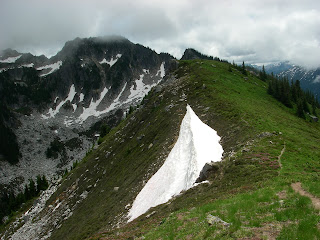A generation of hikers have never seen what lies beyond milepost 12.0 of the 23 mile-long Suiattle River Road – and many who have seen it, have missed out on all the Suiattle region has to offer since a series of washouts in 2003, 2006, and 2007 have steadily gnawed away at the road. An important portal to the west side of the Glacier Peak Wilderness Area, the Suiattle River Road, which runs along the Suiattle River northwest of Darrington, has been missed by many Northwesterners. Nearly a decade later, the road is still not repaired. To some, this blog post is a reminder to what we’ve been missing – to others, it’s a primer.
 |
| Sulphur Mtn. fire lookout site and the true summit beyond |
Initially a Native American route used for hunting and trading across the Glacier Peak region, then later a logging railroad grade, the present-day Suiattle Road was built in phases, completed around 1931. Generations of people have enjoyed the wild places of the Suiattle River, including renowned guidebook author and conservationist Harvey Manning, who received his advocacy epiphany high on the flanks of the mountains above the Suiattle River (see pg 62 of linked article).
Trails wind through old growth forests, popping out at high mountain lakes and meadow- laden ridges that lead to glaciers and thick walls of volcanic ash deposited by Glacier Peak, Washington’s most remote volcano. Destinations accessed by the Suiattle River Road include the Pacific Crest Trail (PCT), the Suiattle River Trail, Miner’s Ridge Fire Lookout, the Milk Creek trail, Lime Ridge, Sulphur Mountain trail, Bath Lakes High Route, Sulphur Hot Springs, Green Mountain Lookout, Huckleberry Mountain trail, Downey Creek trail, the Ptarmigan Traverse and Dome Peak. Popular drive-in campgrounds near the roads end include Sulphur Creek, Buck Creek and Downey Creek.
On October 21, 2003, nearly 10 inches of rain fell in the Suiattle watershed. Floodwaters swept away multiple bridges, including the 265 foot-long Skyline Bridge, as well as a steel -beam bridge that led to the Milk Creek trail, and Boundary Bridge, the automobile bridge that spanned the river at Forest Road 25.
The Suiattle Road suffered a washout at milepost 14.4, and further down the road, the river scoured the bank away from the foot of the Downey Creek Bridge Sulphur Creek Bridge
Over the years, undaunted hikers constructed various styles of ladders to clamber onto the Downey Creek Bridge and beyond.
In 2006, more floods added damage to the ailing Suiattle Road. This flood was especially devastating, because now the road ends at milepost 12, making each trailhead that much farther away.
And so time goes by. In 2007, milepost 6.0 was severely damaged and the Forest Service built a temporary re-route. The Boundary Bridge was repaired in 2010, and a new bridge spanning the Suiattle at the PCT was completed in 2011, marking the official re-opening of the PCT on the west side of Glacier Peak , administratively closed since 2003.
So – What’s taking so long to fix the road? Stay tuned!
In the meantime, pull out your Green Trails maps and peruse 112 Glacier Peak, 79 Snowking, 80 Cascade Pass, and 144 Benchmark….


